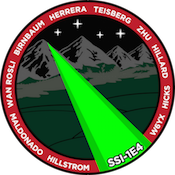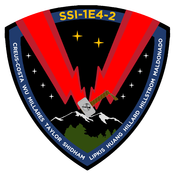Difference between revisions of "Optical Communications Team"
Smaldonado (talk | contribs) (Updated) |
Smaldonado (talk | contribs) (Updated with SSI-1E4-2) |
||
| Line 1: | Line 1: | ||
{{opcomms-sidebar}} | {{opcomms-sidebar}} | ||
| − | [[File:SSI-1E4_Small (175x175).png|frame|left| | + | [[File:SSI-1E4_Small (175x175).png|frame|left|Mission patch for the Satellites Team's first successful [[SSI-1E4|10km optical link]], which achieved an optical lock]] |
| + | [[File:SSI-1E4-2.png|thumb|175px|left|On a subsequent test, the team was able to bidirectionally encode and decode a string of bits.]] | ||
| − | Optical Communications is a student-led project that aims to develop the capability to establish high-bandwidth data links over free space. The group began work at the beginning of the 2014-2015 academic year, under the leadership of Thomas Teisberg and Logan Herrera. It was initially formed to investigate the possibility of space-based optical communications, with the intent to participate in the NASA [[CubeQuest Challenge]], a competition for small satellite design, but has since moved away from the competition design constraints | + | Optical Communications is a student-led project that aims to develop the capability to establish high-bandwidth data links over free space. The group began work at the beginning of the 2014-2015 academic year, under the leadership of Thomas Teisberg and Logan Herrera. It was initially formed to investigate the possibility of space-based optical communications, with the intent to participate in the NASA [[CubeQuest Challenge]], a competition for small satellite design, but has since moved away from the competition design constraints. |
| − | Since its inception, the Optical Communications group has evolved to focus on the establishment of long-distance optical links, with the eventual goal of integrating this technology into a CubeSat form-factor satellite for the purposes of space-based communication. In its first year of existence, the group developed a system involving mechanized altitude/azimuth mounts, an original receiver device consisting of a Fresnel lens and photodetector, and a MATLAB pointing algorithm based on reference point alignment. The group’s final test of the 2014-15 year resulted in the successful establishment of an optical lock over [[SSI-1E4|10 kilometers]]. | + | Since its inception, the Optical Communications group has evolved to focus on the establishment of long-distance optical links, with the eventual goal of integrating this technology into a CubeSat form-factor satellite for the purposes of space-based communication. In its first year of existence, the group developed a system involving mechanized altitude/azimuth mounts, an original receiver device consisting of a Fresnel lens and photodetector, and a MATLAB pointing algorithm based on reference point alignment. The group’s final test of the 2014-15 year resulted in the successful establishment of an optical lock over [[SSI-1E4|10 kilometers]]. The group was able to successfully transmit encoded data over 10 kilometers in August 2015. |
<noinclude>[[Category:Optical Communications]]</noinclude> | <noinclude>[[Category:Optical Communications]]</noinclude> | ||
Revision as of 07:34, 23 September 2016

Optical Communications is a student-led project that aims to develop the capability to establish high-bandwidth data links over free space. The group began work at the beginning of the 2014-2015 academic year, under the leadership of Thomas Teisberg and Logan Herrera. It was initially formed to investigate the possibility of space-based optical communications, with the intent to participate in the NASA CubeQuest Challenge, a competition for small satellite design, but has since moved away from the competition design constraints.
Since its inception, the Optical Communications group has evolved to focus on the establishment of long-distance optical links, with the eventual goal of integrating this technology into a CubeSat form-factor satellite for the purposes of space-based communication. In its first year of existence, the group developed a system involving mechanized altitude/azimuth mounts, an original receiver device consisting of a Fresnel lens and photodetector, and a MATLAB pointing algorithm based on reference point alignment. The group’s final test of the 2014-15 year resulted in the successful establishment of an optical lock over 10 kilometers. The group was able to successfully transmit encoded data over 10 kilometers in August 2015.
